China is a country to be experienced. From sacred mountains to hidden temples, every corner holds stories worth reliving time and time again. In this guide, we’ve gathered some of the country’s most impressive places to help you start dreaming about your trip. And if you want to explore them with people who truly know their essence, GuruWalk offers unforgettable free tours in major cities, helping you connect with their history beyond what the guidebooks tell you.
The Forbidden City

The Forbidden City, in the heart of Beijing, is a time capsule that holds half a millennium of imperial Chinese history.
Located just north of Tiananmen Square, right at the center of the capital, this complex of more than 900 buildings was home to 24 emperors from the Ming and Qing dynasties. It’s not just vast — it’s majestic, symmetrical, and deliberately designed to awe anyone who dared to enter. Every element, from the dragons carved into the eaves to the orientation of the doors, is full of symbolism.
Getting there is easy: just take Line 1 of the Beijing subway and get off at Tiananmen East or Tiananmen West. From there, a short walk leads directly to the southern entrance. The main access point is the iconic Meridian Gate, the same one through which imperial officials once marched.
Even if you lose yourself among halls and pavilions, the most striking part isn’t what you see — it’s what you sense. This is where wars, alliances, and destinies were shaped. Silence once ruled here, and the people’s lives felt far away. Today, thousands of visitors walk those same paths, camera in hand, trying to capture what can only truly be grasped by being there: the scale, the solemnity, the living histo
The Great Wall of China

You don’t just visit the Great Wall, you walk it. You don’t need to cover all of its 20,000 kilometers to grasp its scale; just a few steps along one of its more accessible sections are enough to feel its power. Built over centuries to defend the Chinese Empire, it remains one of the most iconic structures on the planet and it’s still standing.
From Beijing, the easiest way to see it is by heading to one of the restored sections: Badaling is the most popular and touristy; Mutianyu is quieter, surrounded by forested mountains. Both are reachable in under two hours by car or bus. For a wilder experience, Jinshanling or Simatai offer less crowded stretches, perfect for those who want to walk in near solitude among crumbling towers and stone paths.
As you move along the wall, it winds through hills and valleys, climbs steep peaks, and disappears into the horizon. There’s no single viewpoint to take it all in, every step shifts your perspective. That’s why it’s more than just a monument. It’s an experience.
The Temple of Heaven
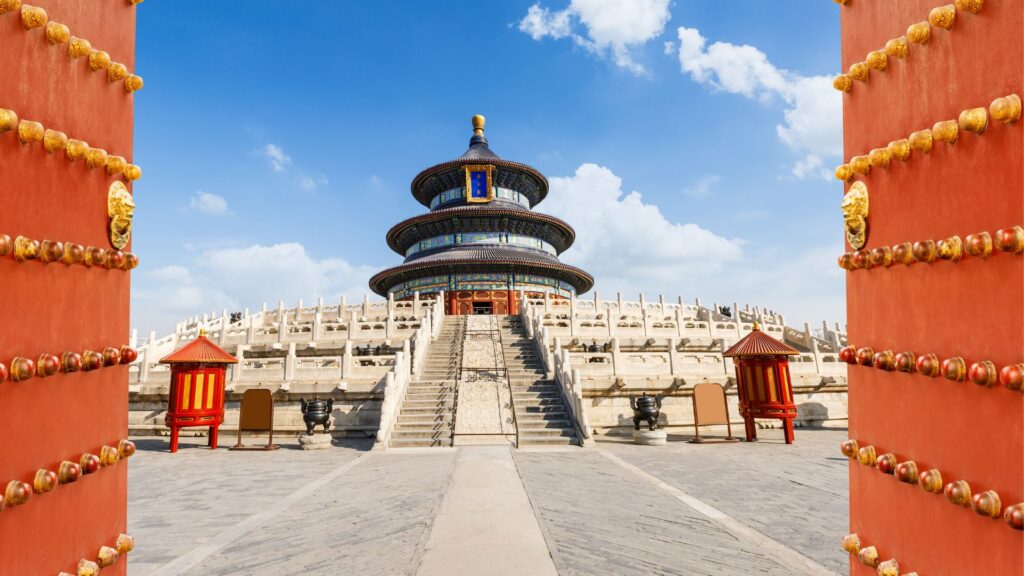
In the south of Beijing, inside a vast, tree-lined park, stands one of the most harmonious structures in all of China: the Temple of Heaven. This wasn’t just any place. Here, emperors came to pray for good harvests and cosmic balance. And yes, you can feel it.
Unlike the Forbidden City, designed to impress, the Temple of Heaven radiates calm. Its most iconic structure is the Hall of Prayer for Good Harvests: a circular, perfectly symmetrical building with deep blue roofs and not a single nail holding it together. Everything here is designed to connect heaven and earth, the emperor and the divine.
You can easily get there from central Beijing by subway, getting off at Tiantan Dongmen Station (Line 5). The east entrance is just a short walk from the main halls. If you go early in the morning, you’ll see locals practicing tai chi or flying kites, giving a casual rhythm to a place that was once deeply sacred.
The Summer Palace in Beijing
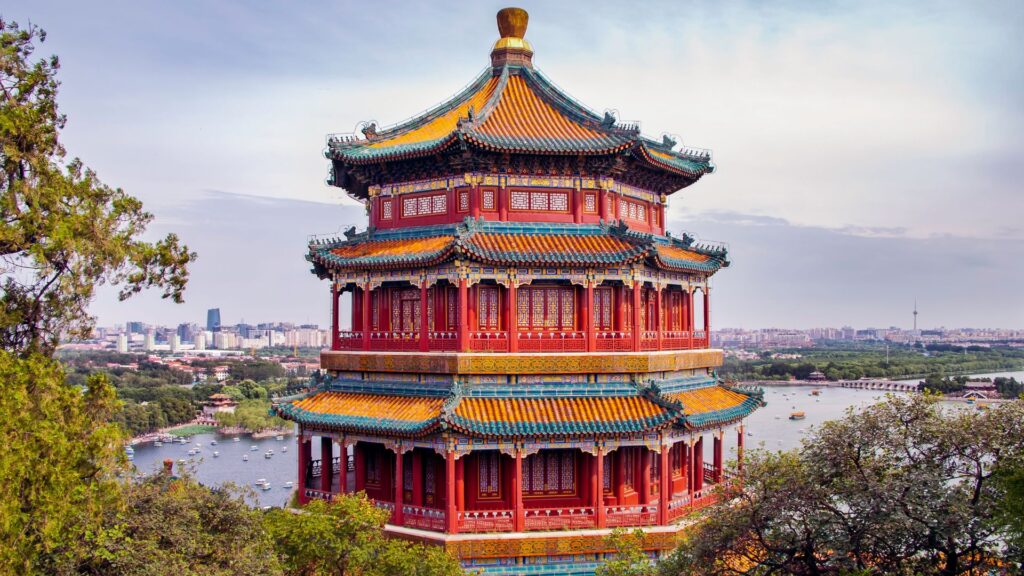
The emperor needed to escape the heat too. And when he did, he did it in style. The Summer Palace, about 15 kilometers northwest of downtown Beijing, was his retreat during the warmest months. Surrounded by hills, gardens, and the vast Kunming Lake, this complex is a masterclass in balancing power and landscape.
You can get there by subway (Line 4, Beigongmen Station) or by taxi from anywhere in the city. It’s best to set aside at least half a day to explore it without rushing. There isn’t one main highlight, but rather a collection of remarkable spots: the world’s longest covered corridor, temples, bridges, the Marble Boat that floats — quite literally — on the water, and the imposing Hall of Benevolence and Longevity.
The lake, though artificial, takes up three quarters of the grounds. A boat ride is optional, but climbing Longevity Hill is almost essential. The view from the top makes it clear why this place was once considered a paradise on earth
The Silk Market in Beijing

This isn’t just any market. It’s a bargaining battlefield, an adventure for those who enjoy the game of haggling, knockoffs, and unexpected finds. The Silk Market, also known as Xiushui, is located in the Chaoyang District of Beijing and is one of the most famous (and controversial) shopping spots in China.
From Yong’anli Station (Line 1), you’ll exit almost directly in front of the building. Inside, you’ll find several floors packed with stalls selling clothes, bags, electronics, souvenirs, and — of course — silk products. Not everything that glitters is authentic, but that’s part of the charm.
You come here to negotiate. The first price is never the real one, and a smile is just as important as patience. If you play it well, you walk away with more than a good deal — you walk away with the story of a fight well fought.
And while many visitors come in search of brand-name knockoffs, the market is also a good place to find crafts, custom-made shoes, or traditional outfits. You just have to know how to look — and not be afraid to say no.
The Lama Temple in Beijing

In the middle of Beijing’s hustle and bustle, there’s a place where incense fills the air and silence takes over. The Lama Temple, or Yonghe Gong, is the most important Tibetan Buddhist monastery in northern China and an essential stop for anyone seeking a deeper understanding of the Chinese soul.
It’s located in the Dongcheng District. Getting there is easy: just take Line 2 or Line 5 of the subway and get off at Yonghegong Lama Temple Station. From there, the entrance is direct. Guarded by stone lions, it marks the transition from the modern city to a space of spirituality.
The complex consists of a series of pavilions arranged in a line, each more intricate than the last. At the far end awaits its treasure: an 18-meter-tall statue of Maitreya, carved from a single piece of white sandalwood. It’s truly striking.
You don’t have to be religious to feel something special here. It’s enough to watch the faithful, listen to the murmur of prayers, or pause in front of the murals and carved details. The Lama Temple isn’t just something you look at. It’s something you breathe, hear, and above all, respect.
Potala Palace, Mount Hongshan
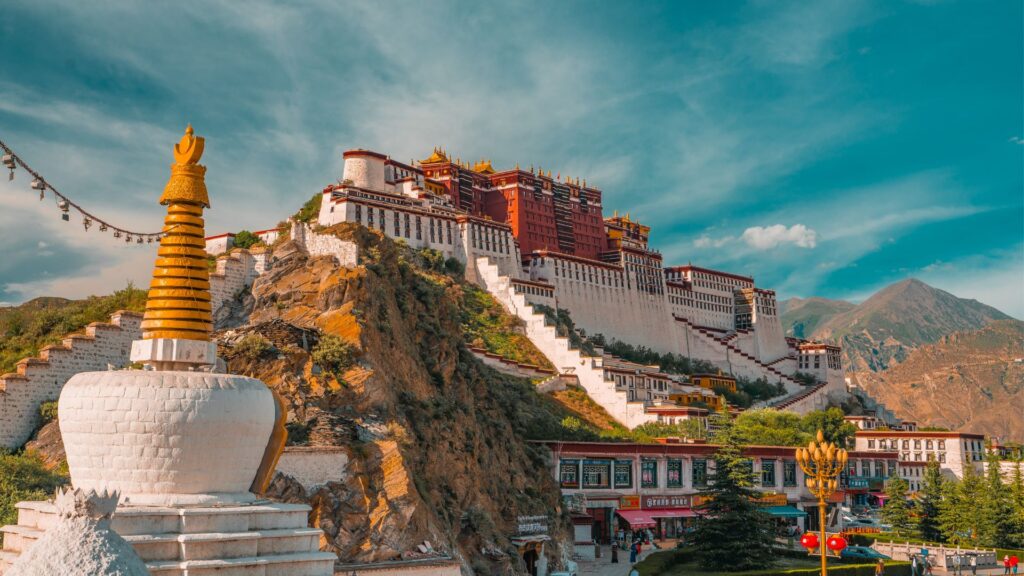
In the heart of Tibet, more than 3,600 meters above sea level, stands the Potala Palace, perched like a white and crimson crown on the slope of Mount Hongshan. From below, in Lhasa, its silhouette dominates everything. And from the top, the view is overwhelming: golden rooftops, open valleys, and the distant hum of the city.
This is not just a building; it is a symbol. Once the political and spiritual center of Tibetan Buddhism, it served as the residence of the Dalai Lama for centuries. Today, it is a UNESCO World Heritage Site and one of the greatest achievements of religious architecture in the world. The complex is divided into two parts: the Red Palace, dedicated to study and prayer, and the White Palace, which housed the living quarters of spiritual leaders.
To get there, the usual starting point is the city of Lhasa, the capital of Tibet. While it has an airport, the most spectacular route is the Qinghai-Tibet Railway, which crosses through surreal landscapes from Xining. Once in Lhasa, the palace is just minutes from the city center, though the climb on foot takes some patience and a bit of oxygen.
Inside, the walls smell of wax and centuries. Chapels, sacred tombs, manuscripts, and statues fill more than a thousand rooms. And yet, the most powerful thing is the silence: the one that falls when you enter, and the one that stays with you after you leave.
Tiger Hill, China

Tiger Hill (Hu Qiu), in the city of Suzhou, is no ordinary hill. At just 36 meters high, it holds more legends, history, and beauty than its modest size suggests. It’s a place where nature, architecture, and storytelling blend effortlessly.
Getting to Suzhou from Shanghai takes only about thirty minutes by high-speed train. Once there, a taxi or bus will get you to the entrance of the site in under twenty minutes. The park surrounding the hill is spacious, with canals, centuries-old bonsai trees, and paths that invite you to wander without a map.
Tiger Hill’s most famous feature is its Leaning Pagoda, known as the Yunyan Tower. Over a thousand years old, its tilt rivals that of Pisa, though far less publicized. You’ll also find the Sword Pool, where legend says a king’s sword was buried along with a thousand warriors.
But beyond the landmarks, what makes Tiger Hill special is its atmosphere. The sound of flowing water, the scent of tea from nearby houses, and the shaded trails create a calm, profound setting. Here, it feels as if the past quietly comes back to life.
Tianmen Mountain
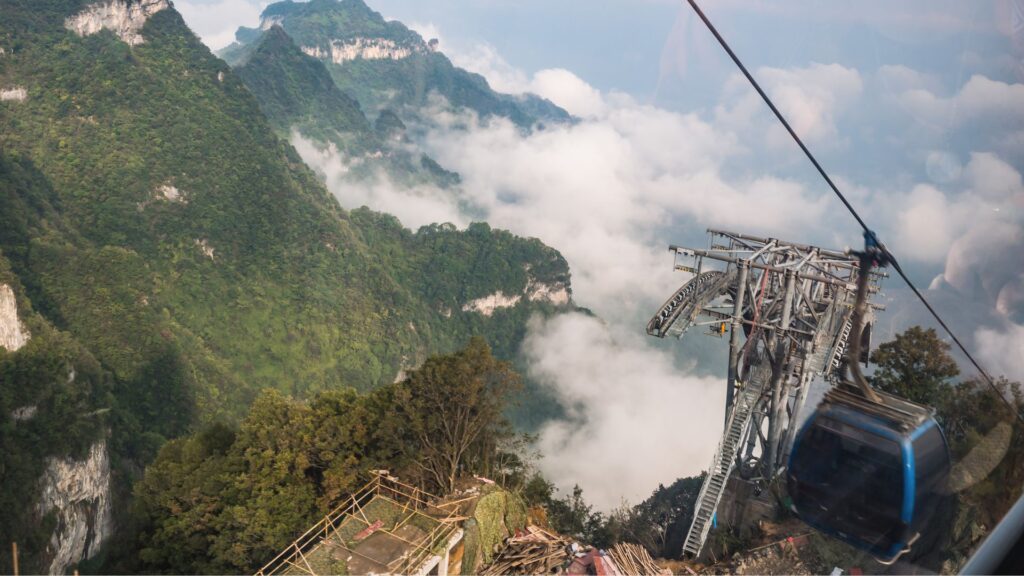
First, the cable car. The longest in the world. Almost 30 minutes suspended over cliffs, vertical forests, and impossible curves. That’s how a visit to Tianmen Mountain begins, in Hunan Province, just outside the city of Zhangjiajie.
From Zhangjiajie, getting there is easy: the cable car departs directly from the city center. You can also take a bus up the famous 99-bend road, then climb more than 999 steps to reach the Heaven’s Gate, a natural opening 131 meters high carved into the cliffside. It’s no exaggeration to say it’s awe-inspiring.
At the top, the experience becomes surreal. Hanging walkways, glass-bottomed viewpoints, and paths carved straight into the rock twist along the edge of the abyss. The glass skywalk isn’t for the faint of heart, but it’s unforgettable.
And when the clouds descend, everything changes. The mountain turns otherworldly, as if you were walking through a dream. It’s no surprise this landscape inspired the setting for the movie Avatar.
Jade Buddha Temple in Shanghai

Amid the electric pace of Shanghai, between skyscrapers and avenues that never sleep, there’s a quiet corner where time slows down: the Jade Buddha Temple. It’s one of the most famous Buddhist temples in China, not because of its size, but because of what it holds.
From the city center, it’s easy to reach by subway. Line 13 takes you to Jiangning Road Station, just a short walk from the temple grounds. And while the exterior might seem modest compared to other Chinese temples, inside it houses one of the spiritual treasures of the East: a seated Buddha statue carved from white jade, brought from Burma in the late 19th century.
The statue stands under two meters tall but is full of detail: inlaid with precious stones, serene in expression, and commanding in presence without saying a word. There is also a reclining jade Buddha, representing his entry into nirvana. Both are set in spaces filled with the scent of incense and the soft murmur of prayers.
The temple is still active, something to keep in mind when visiting. Monks come here to pray, so as a sign of respect, visitors usually, and should, lower their voices to avoid disturbing the silence.
West Lake (Hangzhou)

Anyone who has walked along the shores of West Lake understands why Chinese poets have written about it for centuries. Located in Hangzhou, just an hour by train from Shanghai, this lake doesn’t impress with its size or grand monuments, but with the harmony of its landscape.
Walking its banks means crossing stone bridges, passing pagodas tucked among trees, and watching wooden boats glide slowly across the water. On one side, green hills. On the other, the city fading into the background. In the middle of the lake, three small pagodas rise from the water and are lit during festivals. It’s the lake’s most iconic image, even featured on yuan banknotes.
Getting there is easy: from Hangzhou Railway Station, a taxi or the metro will take you to any of the lake’s entrances within minutes. The area is open, with no main gate or fixed route, so the best way to explore is on foot or by renting a bicycle to find your own path.
Longji Rice Terraces (Longsheng)
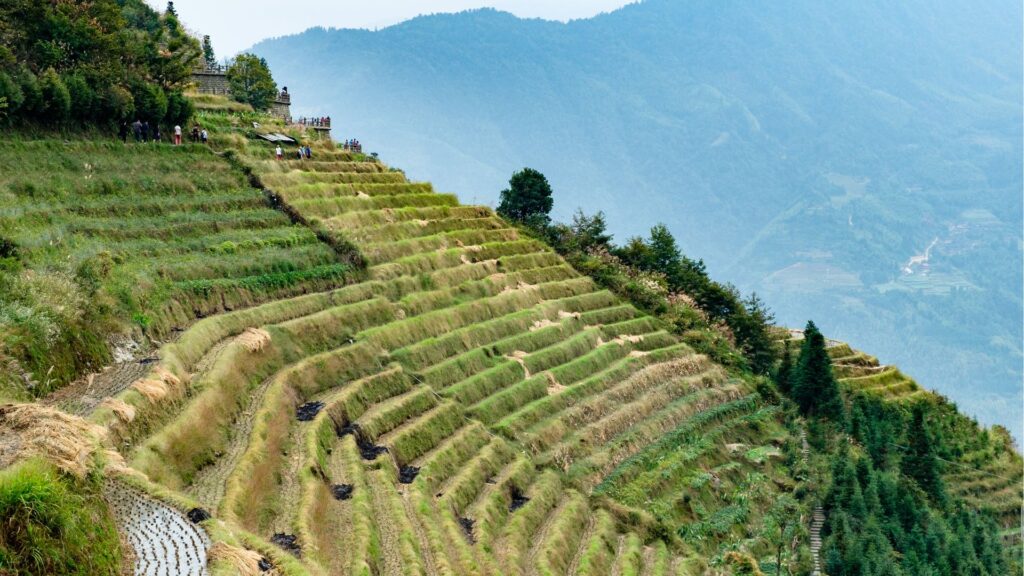
Watching the sunrise over the Longji Rice Terraces feels like looking at a landscape patiently combed over centuries. The rice fields trace the shape of the mountains like green staircases that change color with the seasons: bright green in summer, golden in autumn, shimmering with water in spring.
These terraces are in the Longsheng region, about two hours by car from the city of Guilin, in Guangxi Province. From there, most travelers arrange transport to Ping’an or Dazhai, two villages nestled in the hills that serve as perfect bases for exploring the area. The final stretch is done on foot, along well-marked but steep paths surrounded by bamboo and quiet.
The magic is not only in the views, which are truly striking, but also in what you experience along the way. You will meet Yao women in traditional dress, see wooden houses clinging to the mountain, and pass rice paddies still worked using time-honored techniques. There is no city noise here. The pace is set by the land.
Mogao Caves (Dunhuang)

On the edge of the Gobi Desert, where sand consumes everything and the wind shows no mercy, there is a place that seems almost unreal: the Mogao Caves. More than a thousand years of history painted into stone, hidden near the city of Dunhuang, in Gansu Province.
This Buddhist sanctuary began as a spiritual refuge along the Silk Road. Merchants, monks, and travelers stopped here not just to rest, but to leave a part of themselves behind. The result is nearly 500 temples carved into the cliffs, adorned with murals, statues, and manuscripts that trace the evolution of Buddhism and Asian art like a monumental visual narrative.
To get there, you’ll need to fly or take a train to Dunhuang. From the city center, the site is about 25 minutes away by bus or taxi. Visits are regulated and guided, and it’s best to book in advance. This is not a place for crowds, and it is better that way.
Inside, the darkness protects the colors, and silence speaks louder than words. Just be aware that photography is not allowed.
Zhangjiajie National Forest Park (Hunan)
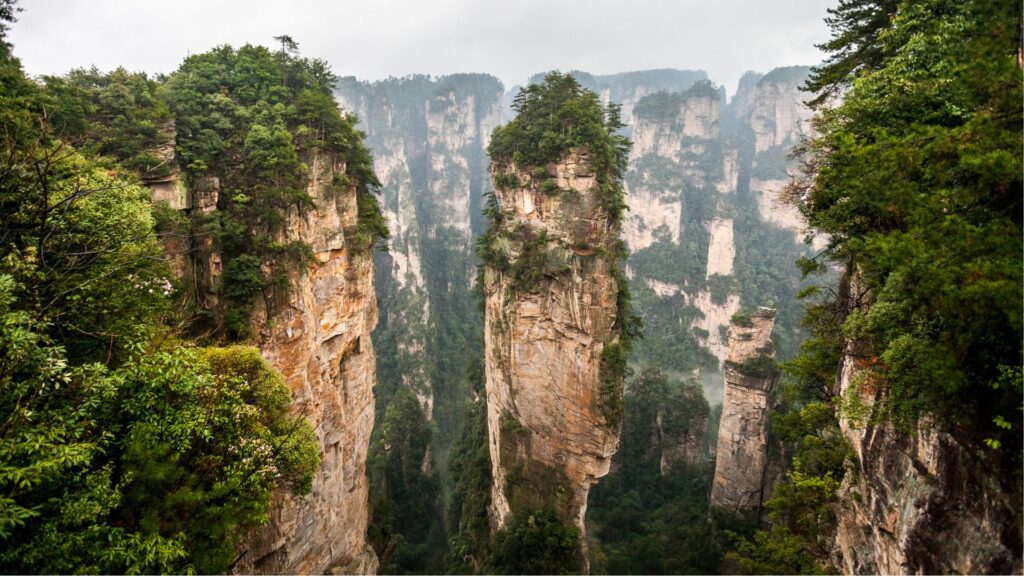
If you’ve ever dreamed of walking among floating mountains, this is the place. Zhangjiajie National Forest Park, in Hunan Province, is unlike anything else. It is a forest of stone pillars shooting toward the sky as if the earth itself were pushing them upward. Here, gravity feels optional.
From the city of Zhangjiajie, the park is easy to reach by bus or taxi in under an hour. The main entrance is in the Wulingyuan area, and from there, dozens of trails, viewpoints, cable cars, and walkways allow you to explore the park at different heights.
The most famous spot is Avatar Hallelujah Mountain, named after the film that made it globally recognizable, though locals revered it long before Hollywood arrived. But there is more. The Bailong Elevator, made of glass and attached to the cliff, takes you up to the clouds in seconds. The Zhangjiajie Grand Canyon features a glass bridge suspended over the abyss. Bamboo forests and foggy trails complete the picture.
You don’t need to be a mountaineer. The park is accessible to all levels, but it’s worth taking your time and wearing proper shoes. This is not about reaching a destination. It’s about discovering views that look like they belong to another world.
Mount Emei (Emeishan)
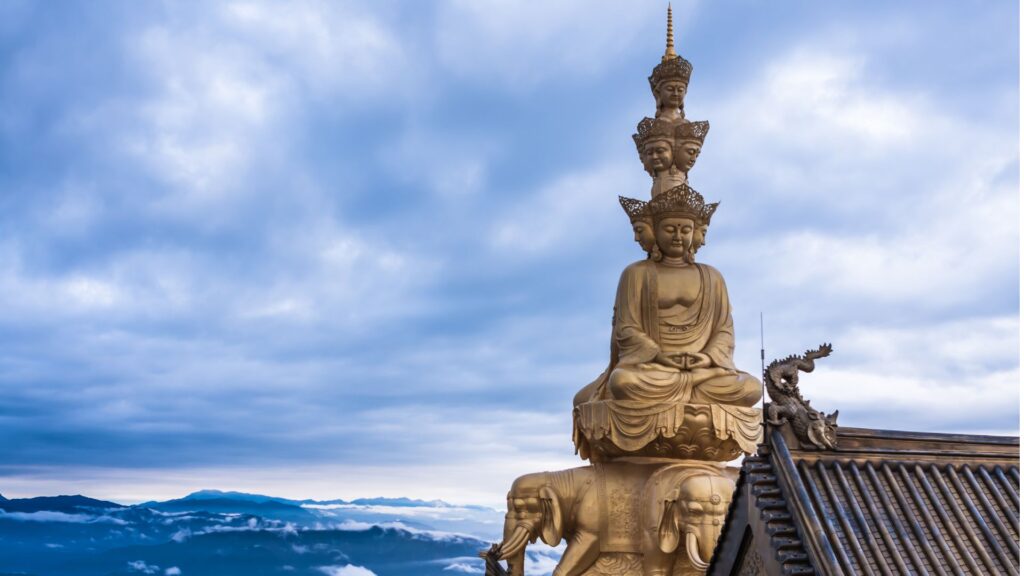
Climbing Mount Emei is not just a hike. It is an inner journey. One of the four sacred mountains of Chinese Buddhism, located in Sichuan Province near Chengdu, this place blends nature, spirituality, and physical effort into an experience that stays with you.
From Chengdu, it’s easy to reach Emeishan City by high-speed train. From there, shuttle buses take you to the base of the mountain or even higher up if you want to save your energy. But those who choose to walk from the bottom pass through temples, cedar forests, endless stairways, and the occasional curious monkey.
At the summit awaits the Golden Platform, the Great Samantabhadra Buddha riding on elephants, and if the clouds lift, one of the most breathtaking views in all of southwestern China. At over 3,000 meters above sea level, the air feels different. Silence is heavier. The clouds do not drift past you, they pass through you.
The mountain is dotted with temples where pilgrims can sleep and eat a warm meal. Here, Buddhism is not displayed. It is lived. Monks pray without an audience. Devotees climb barefoot. The journey matters as much as the destination.
And while the body may end the day tired, the mind comes down lighter.
Discover the Best Free Walking Tours in Beijing
Meeting guide at the metro station: line 8 or Line 6 Nan luo gu xiang station exit E. Highligh…
🎆Hello curious traveler! Welcome to the FIRST, ORIGINAL , and BEST-RATED free walking tours i…
Meet guide by the Metro line 7 or 8 Zhushikou Station Exit A. In Chinese 地铁7号线珠市口站A出口 Please carry passport wit…
Important – Please Read Before Booking Booking Policy F…
Step beyond the postcard panoramas and unlock the hidden cosmological language of Beijing’s Temple of Heaven—a UNESCO site whe…
I will wait for you at Metro line 4 Beigongmen station Exit C. From downtown Beijing to summer palace …
Join us on this journey through Beijing's old cultural hub, where hidden sites and rarely-told tales bring its most turbulent…

